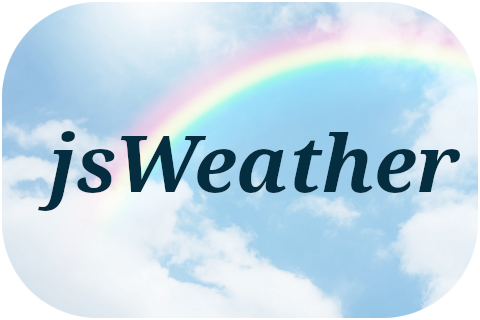
jsWeather offers a solution for preparing generally available weather data and displaying it in a user-friendly way. For this, the easy and safe to use weather application interface (API) from "OpenWeatherMap" is used.
OpenWeatherMap is a commercial online service that provides an interface for retrieving weather data, weather forecasts, and historical weather data for web application and mobile device developers. Some of the available data can be accessed after a registration for free.
With the use of OpenWeatherMap three program developments have been realized:
- jsWeather php class for simplified use of the OpenWeatherMap API
- jsWeather - a module for Joomla version 4 and version 5
- Web application for a weather forecast
jsWeather Joomla Module
Weather in New York
19th April, 2024 - 18:34
Overcast Clouds
Humidity: 77 %
Wind: 17.3 mph North-East
Pressure: 1,021 hPa
Visibility: 32,808 ft
|
jsWeather is a lightweight and versatile Joomla module that displays weather information for any location, including information such as, humidity, barometric pressure, wind, visibility. It was developed using the latest current version of openWeatherMap as weather data source. Key features of jsWeather include:
|
Weather forecast for London - 
19th April, 2024
Light Rain
 13°C
13°C
Precipitation: 24%
Wind: 21.7 km/h NW
Visibility: 10,000 m
Pressure: 1,017 hPa
|
20th April, 2024
Broken Clouds
 10°C
10°C
Precipitation: 0%
Wind: 18.6 km/h N
Visibility: 10,000 m
Pressure: 1,029 hPa
|
21st April, 2024
Overcast Clouds
 9°C
9°C
Precipitation: 0%
Wind: 18.0 km/h NE
Visibility: 10,000 m
Pressure: 1,032 hPa
|
22nd April, 2024
Scattered Clouds
 12°C
12°C
Precipitation: 0%
Wind: 18.4 km/h NE
Visibility: 10,000 m
Pressure: 1,030 hPa
|
23rd April, 2024
Overcast Clouds
 9°C
9°C
Precipitation: 0%
Wind: 10.1 km/h NW
Visibility: 10,000 m
Pressure: 1,023 hPa
|
|
1. Installation
You can install the jsWeather Module on your Joomla site using the Install from Web Catalog method because the jsWeather Module is available in the Joomla Extensions database. Or you may download the jsWeather Module installation file from my website and install it via the admin backend.2. Configuration
To use the module you need to get the free API key from OpenWeatherMap". Then open the setup menu for modules in the Joomla admin backend via "system->site modules" Click the "New button" in the menu and then select the module "jsWeather".This opens the HTML form for configuring the module. Please use the necessary information for the configuration with the option "Toggle inline help" in the form. This displays help-texts for the respective module settings. Furthermore, take care on the other necessary Joomla settings (e.g. "Position", "Status", Menu assignment, etc.). For example, you can use options to select the "default", "horizontal" ore "forecast" module layouts.
Jooomla plugin "loadmodule"
The Joomla Core content plugin "loadmodule" allows embedding Joomla modules into Joomal articles.Since Joomla version 3.9.0, in addition to the plugin alternatives "{loadposition xx}" and "{loadmodule yyy}", there is the variant "{loadmoduleid z}, which is also implemented by the plugin.
In this case, the plugin looks for the module whose id corresponds to the number z. For example, you can insert the module with the "id 200" into the article by inserting the plugin tag "" into the article text.
Application and use
To use the jsWeather module, the following steps must be carried out:- Create a jsWeather module via admin backend
Note: do not assign a module position, leave this undefined. - Note (remember) the ID of the module
- Create/edit a Joomla article
- Insert the plugin tag "{loadmoduleid x}" ("x" = module ID) into the Joomla article
jphpx Ajax interface
If the extension "jphpx" is installed, you can implement an interactive solution from jsWeather as an alternative. This makes it possible to request the relevant weather information by entering any weather location. You can see the solution here:
Installation of the jphpx Ajax interface
The necessary prerequisite is the installation of "jphpx " and the jsWeather Module. With version 1.2. jsWeather also provides all the necessary components for an implementation:
- html code and scripts for the user interface
- Scripts for integrating and rendering the modules in the Joomla article
Configure solution
The following steps are necessary for a successful implementation:
-
Create jsWeather modules
Create 2 jsweather modules, one for the current weather (Module Type "current Weather" and one for the weather forecast (Module Type "Weather Forecast").
Note: do not assign module positions, leave these undefined. Write down (remember) the titles of these two modules (the titles should not contain any spaces or special characters) -
Set up jphpx code entry
Using the “Components” menu item in the administrator backend, you select the “jphpx Application” or “jphpx Code Entry” option. This calls the component and you can now define a new jphpx application using the “New” button. Define the code source with the value
"modules/mod_js_weather/load_jsweather.php". After saving, write down (remember) the "id" of the new jphpx code entry. -
Check runtime parameters
The runtime parameters are used to customize the HTML code and scripts for the user interface. To do this, edit the file: jphpx_loadmodule.inistored in directory
"../modules/mod_js_weather". To may do this, using the editing function of the FTP client “Fillezilla” or a similar tool. The meanings of the parameters are provided in the file. The following settings must be changed to your configured values of modules and jphpx component.- "id" - jphpx Code Entry Id
- "current" - Title of the module type "current weather"
- "forecast" - Title of the module type "weather forecast"
-
Include jphpx plugin tag
Finally, enter this jphpx plugin tag
"{jphpx [modules/mod_js_weather/jphpx_loadmodule.php]}"
at the location of your Joomla article where the jsWeather modules should be rendered.
Notes
With version 1.1.5 you may use owfont, which is a symbol font for Open Weather Map API. owfont is designed to match to weather condition codes returned by OpenWeatherMap API. It uses the response code as class name (prefixed with owf) and displays the related weather icon.
When using geolocation servers, an attempt is made to deliver the geographic coordinates via the website visitor's Internet address. However, this location allocation can only be as accurate as the respective data provided by the internet providers. IP-based geolocation services can be expected to provide 55 to 80 percent accuracy for a user's region or state.
Weather data are never "precise" they always relate to a more or less large region. It is therefore quite possible that e.g. rain is displayed although there is no rain in sight at the selected location.
If you get a "400" error when entering a valid location, you should enter the place name in lower case and then try the request again. If this also leads to the same error, enter the geographic coordinates of the location.
Download jsWeather
jsWeather is free software (like Joomla!) - however you must follow the GPL license terms to use it. More about GPL and free software can be found at GNU Org.
To download jsWeather click the "download" image:
![]() jsWeather module version 1.2 for Joomla!
jsWeather module version 1.2 for Joomla!
Any questions? Visit the Support Forum or send an email to the developer, our webmaster.














 Joomla extensions help extend the Joomla websites' ability. There are five types of extensions for Joomla!: Components, Modules, Plugins, Templates, and Languages. Each of these extensions handles a specific function.
Joomla extensions help extend the Joomla websites' ability. There are five types of extensions for Joomla!: Components, Modules, Plugins, Templates, and Languages. Each of these extensions handles a specific function.